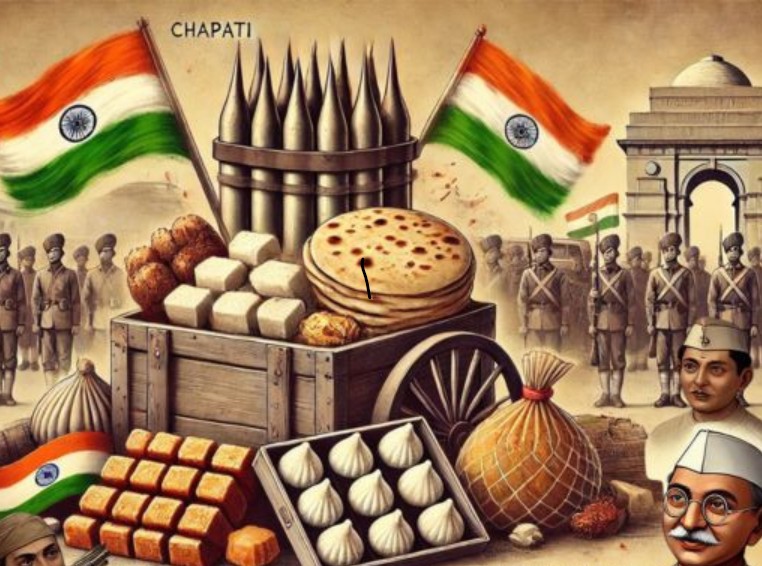When we think of India’s fight for independence, we picture marches, speeches, and satyagrahas. But behind the scenes, food played a surprisingly powerful role—fueling bodies, spreading messages, and uniting communities. From the mysterious Chapati Movement to the symbolic Tiranga Barfi, everyday Indian dishes became tools of rebellion, communication, and solidarity.
Here’s a deep dive into how humble meals helped shape a nation’s destiny.
1. The Chapati Movement: Flatbreads of Defiance
- In 1857, just before the First War of Independence, villagers near Agra began baking and distributing thousands of chapatis
- These chapatis traveled up to 300 kilometers, passed hand to hand by chowkidars and policemen
- Though no written messages were found, their sudden appearance created widespread unrest and confusion among British officials
- The movement was never officially decoded, but it stirred a sense of unity and anticipation across villages
- Chapatis became symbols of silent resistance, showing how food could carry meaning beyond nourishment
2. Tiranga Barfi: Patriotism in Layers
- During British bans on flags and posters, freedom fighters turned to sweets to express national pride
- Raghunath Das Gupta of Varanasi crafted the Tiranga Barfi—layered in saffron, white, and green to mirror the Indian flag
- These tricolor treats were distributed during underground meetings and protests
- Tiranga Barfi became a delicious emblem of courage and creativity, allowing patriots to “taste” freedom
- Even today, sweet shops across India recreate this barfi around Independence Day as a tribute to edible activism
3. Laddoos and Rasgullas: Sweet Sabotage
- Laddoos weren’t just celebratory—they were strategic
- Freedom fighters used sesame and besan laddoos to hide messages, signal plans, and even disguise explosives
- In 1930, a telegram reading “Bengali Sweets Dispatched” triggered panic among British authorities
- They feared a bomb shipment, but the delivery turned out to be juicy rasgullas from Kolkata
- This clever misdirection showcased how food could be used to confuse, distract, and outwit colonial forces
4. Community Kitchens: Feeding the Fight
- During the Vaikom Satyagraha in Kerala (1924–25), over 30,000 chapatis were served daily to protestors
- These kitchens became hubs of unity, breaking caste barriers and nourishing the spirit of resistance
- Food was not just sustenance—it was a statement of equality and shared purpose
- Similar kitchens operated during the Salt March and Quit India Movement, offering meals to volunteers and satyagrahis
- The act of cooking and sharing food became a quiet but powerful form of protest
5. Food as Code and Camouflage
- Boxes of sweets were arranged in Morse-like patterns to convey messages
- Sweet shops doubled as meeting points for revolutionaries, where orders were placed using coded language
- Pinni, a high-energy sweet made from jaggery and ghee, was used to sustain fighters during long journeys
- Salt, central to the 1930 Salt March, symbolized defiance against British taxation and became a culinary rallying cry
- Even tea stalls played a role, hosting secret gatherings and spreading word-of-mouth updates
Final Thoughts
India’s freedom struggle wasn’t just fought with slogans and satyagrahas—it was stirred in pots, wrapped in banana leaves, and served with love. From barfis that waved the flag to chapatis that whispered rebellion, food became a quiet but potent force in the fight for independence. As we celebrate Independence Day, let’s remember that sometimes, the most powerful revolutions begin in the kitchen.
Sources: Times Now, Onmanorama, Maps of India, Times of India, Purioil Mills
